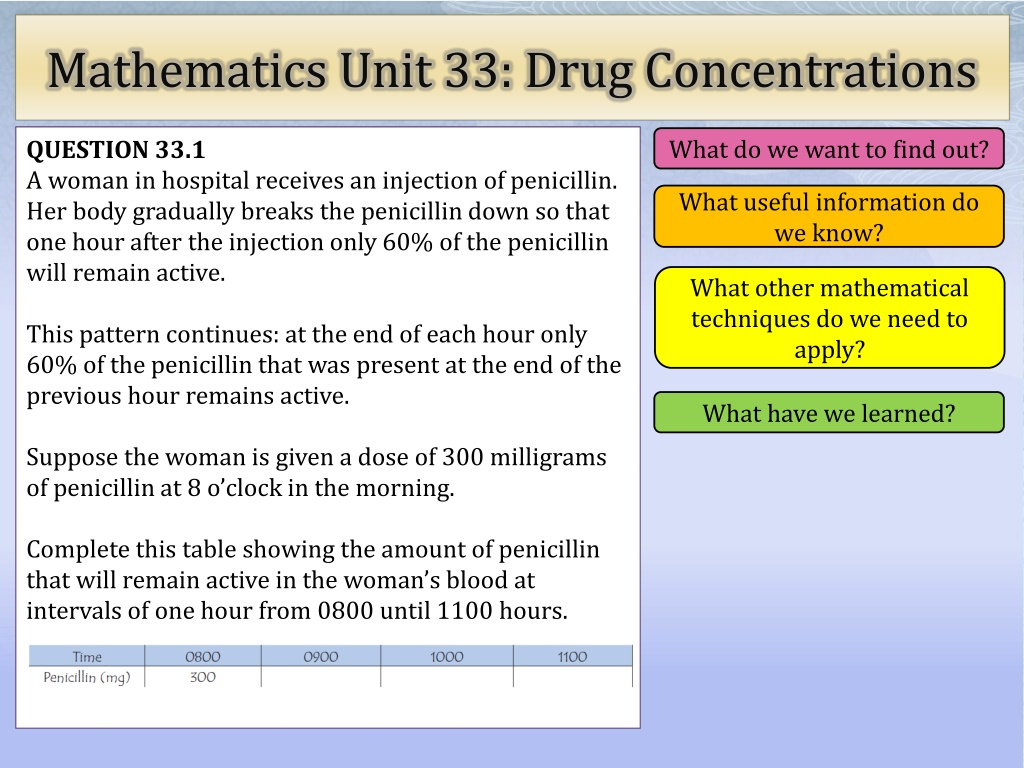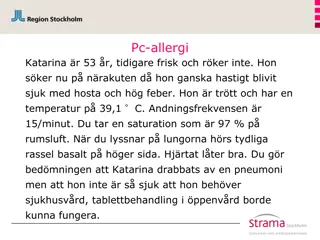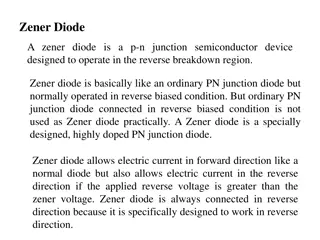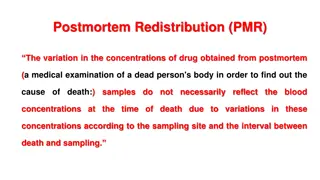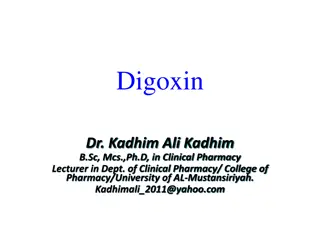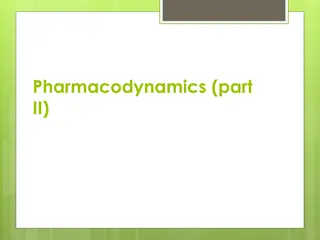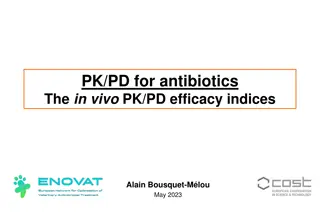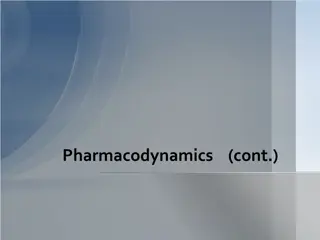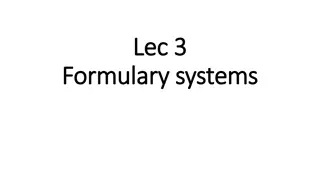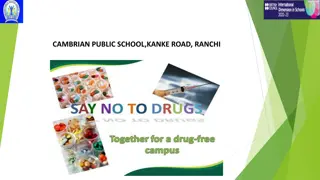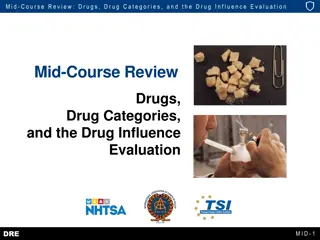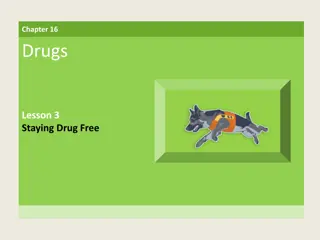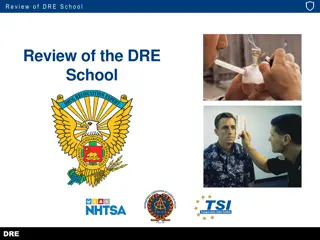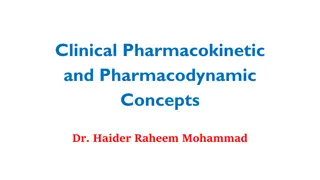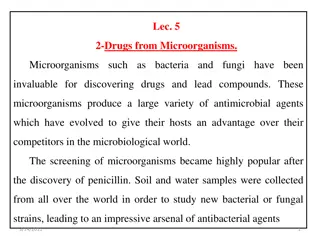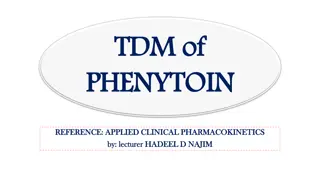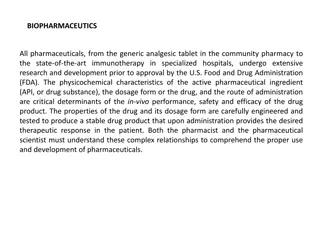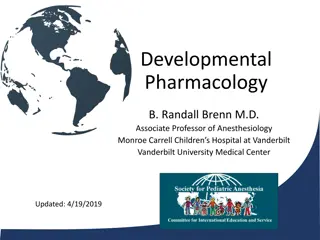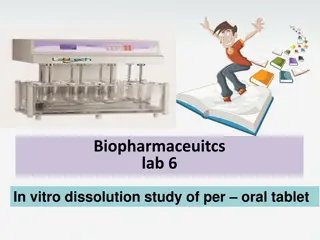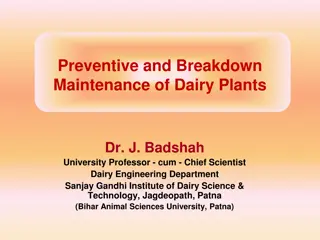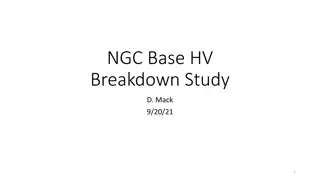Drug Concentrations and Penicillin Breakdown in Body
A woman receiving an injection of penicillin in a hospital gradually breaks down the drug, with only 60% remaining active every hour after the injection. This pattern continues, and a dose of 300 milligrams is given at 8 o'clock in the morning. The amount of active penicillin in the woman's bloodstream at hourly intervals from 8:00 to 11:00 am needs to be calculated.
Download Presentation

Please find below an Image/Link to download the presentation.
The content on the website is provided AS IS for your information and personal use only. It may not be sold, licensed, or shared on other websites without obtaining consent from the author. Download presentation by click this link. If you encounter any issues during the download, it is possible that the publisher has removed the file from their server.
E N D
Presentation Transcript
Mathematics Unit 33: Drug Concentrations What do we want to find out? What do we want to find out? QUESTION 33.1 A woman in hospital receives an injection of penicillin. Her body gradually breaks the penicillin down so that one hour after the injection only 60% of the penicillin will remain active. What useful information do we know? What useful information do we know? What other mathematical techniques do we need to apply? What other mathematical techniques do we need to apply? This pattern continues: at the end of each hour only 60% of the penicillin that was present at the end of the previous hour remains active. What have we learned? What have we learned? Suppose the woman is given a dose of 300 milligrams of penicillin at 8 o clock in the morning. Complete this table showing the amount of penicillin that will remain active in the woman s blood at intervals of one hour from 0800 until 1100 hours.
Mathematics Unit 33: Drug Concentrations What do we want to find out? What do we want to find out? QUESTION 33.1 A woman in hospital receives an injection of penicillin. Her body gradually breaks the penicillin down so that one hour after the injection only 60% of the penicillin will remain active. What useful information do we know? What useful information do we know? What other mathematical techniques do we need to apply? What other mathematical techniques do we need to apply? This pattern continues: at the end of each hour only 60% of the penicillin that was present at the end of the previous hour remains active. What have we learned? What have we learned? Suppose the woman is given a dose of 300 milligrams of penicillin at 8 o clock in the morning. Complete this table showing the amount of penicillin that will remain active in the woman s blood at intervals of one hour from 0800 until 1100 hours. Back to start Back to start
Mathematics Unit 33: Drug Concentrations What do we want to find out? What do we want to find out? QUESTION 33.1 A woman in hospital receives an injection of penicillin. Her body gradually breaks the penicillin down so that one hour after the injection only 60% of the penicillin will remain active. What useful information do we know? What useful information do we know? What other mathematical techniques do we need to apply? What other mathematical techniques do we need to apply? This pattern continues: at the end of each hour only 60% of the penicillin that was present at the end of the previous hour remains active. What have we learned? What have we learned? Suppose the woman is given a dose of 300 milligrams of penicillin at 8 o clock in the morning. Complete this table showing the amount of penicillin that will remain active in the woman s blood at intervals of one hour from 0800 until 1100 hours. Back to start Back to start
Mathematics Unit 33: Drug Concentrations What do we want to find out? What do we want to find out? QUESTION 33.1 A woman in hospital receives an injection of penicillin. Her body gradually breaks the penicillin down so that one hour after the injection only 60% of the penicillin will remain active. What useful information do we know? What useful information do we know? What other mathematical techniques do we need to apply? What other mathematical techniques do we need to apply? This pattern continues: at the end of each hour only 60% of the penicillin that was present at the end of the previous hour remains active. What have we learned? What have we learned? Suppose the woman is given a dose of 300 milligrams of penicillin at 8 o clock in the morning. Complete this table showing the amount of penicillin that will remain active in the woman s blood at intervals of one hour from 0800 until 1100 hours. Back to start Back to start
Mathematics Unit 33: Drug Concentrations What do we want to find out? What do we want to find out? QUESTION 33.1 A woman in hospital receives an injection of penicillin. Her body gradually breaks the penicillin down so that one hour after the injection only 60% of the penicillin will remain active. What useful information do we know? What useful information do we know? What other mathematical techniques do we need to apply? What other mathematical techniques do we need to apply? This pattern continues: at the end of each hour only 60% of the penicillin that was present at the end of the previous hour remains active. What have we learned? What have we learned? Suppose the woman is given a dose of 300 milligrams of penicillin at 8 o clock in the morning. Complete this table showing the amount of penicillin that will remain active in the woman s blood at intervals of one hour from 0800 until 1100 hours. Back to start Back to start
Mathematics Unit 33: Drug Concentrations What do we want to find out? What do we want to find out? QUESTION 33.2 Peter has to take 80 mg of a drug to control his blood pressure. The following graph shows the initial amount of the drug, and the amount that remains active in Peter s blood after one, two, three and four days. What useful information do we know? What useful information do we know? What other mathematical techniques do we need to apply? What other mathematical techniques do we need to apply? What have we learned? What have we learned? How much of the drug remains active at the end of the first day? A. 6 mg. B. 12 mg. C. 26 mg. D. 32 mg.
Mathematics Unit 33: Drug Concentrations What do we want to find out? What do we want to find out? QUESTION 33.2 Peter has to take 80 mg of a drug to control his blood pressure. The following graph shows the initial amount of the drug, and the amount that remains active in Peter s blood after one, two, three and four days. What useful information do we know? What useful information do we know? What other mathematical techniques do we need to apply? What other mathematical techniques do we need to apply? What have we learned? What have we learned? How much of the drug remains active at the end of the first day? A. 6 mg. B. 12 mg. C. 26 mg. D. 32 mg. Back to start Back to start
Mathematics Unit 33: Drug Concentrations What do we want to find out? What do we want to find out? QUESTION 33.2 Peter has to take 80 mg of a drug to control his blood pressure. The following graph shows the initial amount of the drug, and the amount that remains active in Peter s blood after one, two, three and four days. What useful information do we know? What useful information do we know? What other mathematical techniques do we need to apply? What other mathematical techniques do we need to apply? What have we learned? What have we learned? How much of the drug remains active at the end of the first day? A. 6 mg. B. 12 mg. C. 26 mg. D. 32 mg. Back to start Back to start
Mathematics Unit 33: Drug Concentrations What do we want to find out? What do we want to find out? QUESTION 33.2 Peter has to take 80 mg of a drug to control his blood pressure. The following graph shows the initial amount of the drug, and the amount that remains active in Peter s blood after one, two, three and four days. What useful information do we know? What useful information do we know? What other mathematical techniques do we need to apply? What other mathematical techniques do we need to apply? What have we learned? What have we learned? How much of the drug remains active at the end of the first day? A. 6 mg. B. 12 mg. C. 26 mg. D. 32 mg. Back to start Back to start
Mathematics Unit 33: Drug Concentrations What do we want to find out? What do we want to find out? QUESTION 33.2 Peter has to take 80 mg of a drug to control his blood pressure. The following graph shows the initial amount of the drug, and the amount that remains active in Peter s blood after one, two, three and four days. What useful information do we know? What useful information do we know? What other mathematical techniques do we need to apply? What other mathematical techniques do we need to apply? What have we learned? What have we learned? How much of the drug remains active at the end of the first day? A. 6 mg. B. 12 mg. C. 26 mg. D. 32 mg. Back to start Back to start
Mathematics Unit 33: Drug Concentrations What do we want to find out? What do we want to find out? What useful information do we know? What useful information do we know? What other mathematical techniques do we need to apply? What other mathematical techniques do we need to apply? What have we learned? What have we learned? QUESTION 33.3 From the graph for the previous question it can be seen that each day, about the same proportion of the previous day s drug remains active in Peter s blood. At the end of each day which of the following is the approximate percentage of the previous day s drug that remains active? A. 20%. B. 30%. C. 40%. D. 80%.
Mathematics Unit 33: Drug Concentrations What do we want to find out? What do we want to find out? What useful information do we know? What useful information do we know? What other mathematical techniques do we need to apply? What other mathematical techniques do we need to apply? What have we learned? What have we learned? QUESTION 33.3 From the graph for the previous question it can be seen that each day, about the same proportion of the previous day s drug remains active in Peter s blood. At the end of each day which of the following is the approximate percentage of the previous day s drug that remains active? A. 20%. B. 30%. C. 40%. D. 80%. Back to start Back to start
Mathematics Unit 33: Drug Concentrations What do we want to find out? What do we want to find out? What useful information do we know? What useful information do we know? What other mathematical techniques do we need to apply? What other mathematical techniques do we need to apply? What have we learned? What have we learned? QUESTION 33.3 From the graph for the previous question it can be seen that each day, about the same proportion of the previous day s drug remains active in Peter s blood. At the end of each day which of the following is the approximate percentage of the previous day s drug that remains active? A. 20%. B. 30%. C. 40%. D. 80%. Back to start Back to start
Mathematics Unit 33: Drug Concentrations What do we want to find out? What do we want to find out? What useful information do we know? What useful information do we know? What other mathematical techniques do we need to apply? What other mathematical techniques do we need to apply? What have we learned? What have we learned? QUESTION 33.3 From the graph for the previous question it can be seen that each day, about the same proportion of the previous day s drug remains active in Peter s blood. At the end of each day which of the following is the approximate percentage of the previous day s drug that remains active? A. 20%. B. 30%. C. 40%. D. 80%. Back to start Back to start
Mathematics Unit 33: Drug Concentrations What do we want to find out? What do we want to find out? What useful information do we know? What useful information do we know? What other mathematical techniques do we need to apply? What other mathematical techniques do we need to apply? What have we learned? What have we learned? QUESTION 33.3 From the graph for the previous question it can be seen that each day, about the same proportion of the previous day s drug remains active in Peter s blood. At the end of each day which of the following is the approximate percentage of the previous day s drug that remains active? A. 20%. B. 30%. C. 40%. D. 80%. Back to start Back to start
